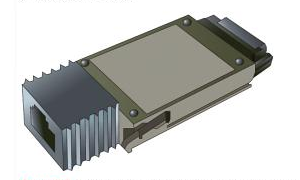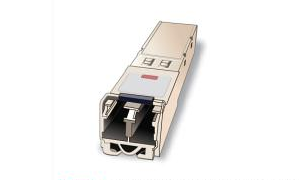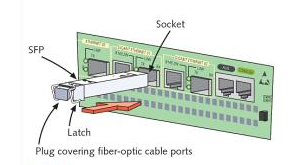It makes sense to purchase workstations or servers with on-board NICs already installed; however, customizing network interfaces on connectivity devices can be more practical on a large network. For example, suppose you were creating a network for a new, fast-growing business.
At first, the business might need only two fiber-optic connections for its backbone and 24 RJ-45, Gigabit Etherent connections for its clients and serves. In the future, however, the business might plan to bring fiber-optic connectivity to every desktop. Rather than ordering a switch that contains exactly this number and type of on-board interfaces, you could order a switch that allows you to change and upgrade its interfaces at any time. The switch would contain sockets that allow one of many types of modular interfaces to be plugged in.
Such interfaces are easily inserted into the sockets to connect with its motherboard, also called a backplane. A hardware component that can be changed in this manner, without disrupting operations, is known as hot-swappable. Using hot-swappable interfaces means you don’t have to purchase a new switch, open the chassis of the existing switch, causing network downtime and risking hardware damage, or even turn off the switch to upgrade the network. Modular interfaces can also be found on some expansion board NICs ang media converters.

GBIC (Gigabit interface converter), pronounced jee-bick, is a standard type of modular interface designed in the 1990s for Gigabit Ethernet connections. GBIC modules may contain RJ-45 or fiber-optic cable ports (such as LC, SC, or ST).

A new modular interface has made the GBIC largely obsolete. SFP (small form-factor pluggable) transceivers provide the same function as a GBIC, but allow more ports per inch-in other words, they are more compact. For this reason, they are also sometimes known as mini GBICs or SFP GBICs. Current SFP standards enable these transceivers to send and receive data at rates up to 10Gbps.

Installing a GBIC or SFP is simply a matter of sliding the transceiver into a socket on the back of the connectivity device. Most SFP modules come with a tab or latch system of locking them into place. They are also keyed so that they will slide into the socket only when they are aligned properly. The switch or router need not be powered down when you add or remove transceivers. However, do not attach cables before inserting a transceiver, and always remove the cables before removing a transceiver.
Some SFPs contain management interfaces separate from the switch’s configuration utility. For example, the 10-Gbps SFP (SFP Plus or SFP+) on a router could have its own IP address. A network administrator could use the Telnet utility to connect to the SFP and configure its ports to use a particular speed or routing protocol without accessing the router’s operating system.
About the Author:
I work for the Fiberstore company and share the information of fiber optic soulutions with the readers. Fiberstore is a largest worldwide supplier of fiber optic transceivers, who provides both GBIC and SFP transceiver modules including J4858A (HP compatible SFP), WS-G5484 (Cisco compatible GBIC) and 10 Gigabit SFP+ etc..




